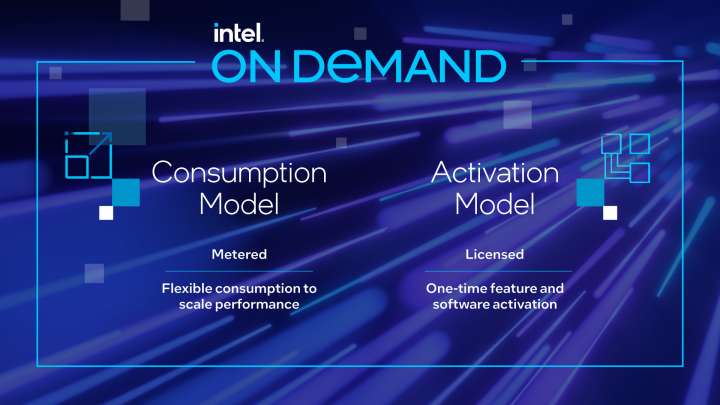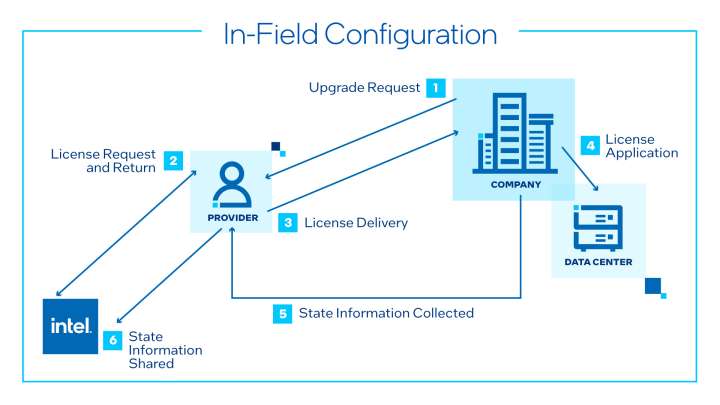Previously, we reported that Intel merged the CPU in-app purchase function (SDSI) into Linux 5.18, and the software-defined chip (software-defined silicon / SDSI) Is a post-manufacturing mechanism that allows additional CPU features to be activated through the purchase of a license.
Now Intel has officially launched an in-app purchase feature called On Demand, which is designed for the upcoming Intel 4th generation Xeon Scalable Sapphire Rapids server processors, which are equipped with various dedicated accelerators and security technologies, but It is not enabled by default, and customers can charge money to unlock various CPU functions.

As you can see from the On Demand homepage, there are two payment modes for additional CPU functions: “consumption mode” and “activation mode”. A buyout is permanently activated. The following figure shows the operation logic of the license:

There are also two types of unlockable CPU functions. One is the CPU accelerator and security functions developed by Intel itself, which can accelerate specific workloads and improve security. Features such as Software Guard Extensions, Dynamic Load Balancer (DLB), Intel Data Streaming Accelerator (DSA), Intel Memory Analysis Accelerator (IAA), Intel Memory Analysis Accelerator, and Intel QuickAssist Technology (QAT) are basically “active modes” , a buyout.
The other category is the functions and services provided by Intel’s partners (H3C, HPE, Inspur, Lenovo, Supermicro, PhoenixNAP, Variscale, etc.), including but not limited to server application optimization, intelligent computing, IaaS solutions, cloud Native and edge computing, etc., these functions and services have both “consumption mode” and “activation mode”.

Intel has not made too many reports on its Intel On Demand plan, and has not yet learned the specific buyout fee of its “activation mode”, nor does it know the “pay-as-you-go” pricing standard.It is only known that it will be used on the server side, because the Xeon Scalable Sapphire Rapids processor is a data center CPU, which was originally scheduled for It will be released at the end of 2021, but it has been postponed, and the latest release date is January 2023.
2010 Intel “Desktop CPU Upgrade Service” Program
As early as September 2010, Intel launched a consumerPaid to upgrade desktop CPU A campaign that allows some low-end desktop CPUs to pay a fee to obtain activation codes to unlock additional features.
The campaign was first launched for the Pentium G6951 desktop CPU (2.8 GHz ), which can enable an additional 1 MB of cache and hyperthreading for a $50 fee (the upgraded CPU model is called “Pentium G6952”), Bringing its performance close to that of a higher-end Core i3-530 CPU.
However, the plan did not have much response, because according to theAt the market price at that time, the Core i3-530 CPU was only $15 more expensive than the standard Pentium G6951… There was no need for consumers to spend $50 to upgrade the G6951.
Later, the activity was extended to the Sandy Bridge series of processors:
- Core i3-2312M (2.1 GHz, 3 MB cache) laptop processor, upgradeable to Core i3-2393M with higher frequency and more cache (2.5 GHz, 4 MB cache)
- Core i3-2102 (3.1 GHz, 3 MB cache) desktop processor, upgradeable to higher frequency (3.6 GHz) Core i3-2153
- Pentium G622 desktop processor (2.6 GHz, 3 MB cache), upgradeable to higher frequency (3.2 GHz) Pentium G693
But the upgrade service for all models did not receive much response, and the “Desktop Upgrade Service” program fell through and was finally terminated in 2011.
#Intel #launched #buy #program #charging #money #unlock #CPU #functions #ElectroDealPro